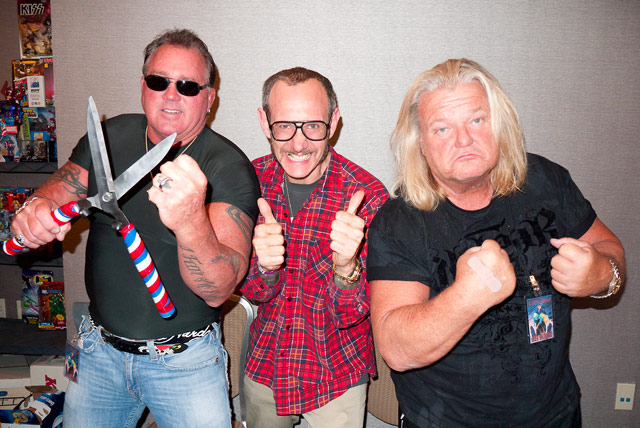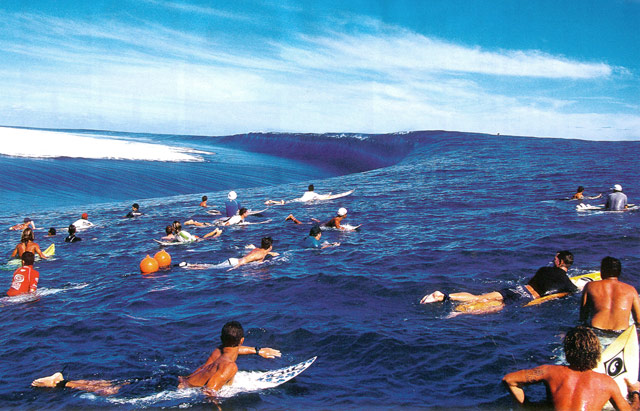The most difficult hole of golf in the world
630 yards. Par 3. Tee is accessible only by helicopter. $1,000,000 for a hole-in-one. Meet the world’s most difficult hole of golf:
(via quora)



This site is made possible by member support. 💞
Big thanks to Arcustech for hosting the site and offering amazing tech support.
When you buy through links on kottke.org, I may earn an affiliate commission. Thanks for supporting the site!
kottke.org. home of fine hypertext products since 1998.
630 yards. Par 3. Tee is accessible only by helicopter. $1,000,000 for a hole-in-one. Meet the world’s most difficult hole of golf:
(via quora)
(Just so I don’t bury the lede too much here: THIS IS INSANE.) Wingsuit flyers keep upping the ante. For awhile, it was enough to glide at 100 mph a foot or two off the ground. Then they started flying through gaps between skyscrapers. And then through holes in mountains. Last year, Gary Connery landed safely in a pile of cardboard boxes without the use of a parachute. And now, watch as Raphael Dumont, straps on his wingsuit, climbs an Italian mountain, and LANDS SAFELY ON A LAKE WITHOUT A PARACHUTE.
Raphael Dumont, human seaplane. That shit cray.
Update: Rumblings on Twitter are indicating that this is fake. I WANT TO BELIEVE. (But that footage of the landing is shot on the world’s shakiest camera for no reason so…)
The NHL season is only a few days old, but Sharks rookie Tomas Hertl may have already scored the goal of the year. This is crazy:
Also, that was his fourth goal of the game. (via grantland)
League of Denial, the Frontline documentary on the NFL and concussions, is available online for anyone to watch for free.
Watch as several kayakers rocket down a drainage ditch in BC at speeds approaching 35 mph.
That looks like a lot of fun. See also what fast looks like. (via devour)
In talking to Bill Simmons for a Grantland NBA preview show, former NBA star Jalen Rose predicts that Michael Jordan will play one game for the Charlotte Bobcats this season.
Per Betteridge’s law of headlines, Jordan will not play in the NBA this season, but it’s an intriguing possibility. Jordan’s 50 years old but he owns the team so you never know.
According to an upcoming book by ESPN reporters Mark Fainaru-Wada and Steve Fainaru, the NFL “conducted a two-decade campaign to deny a growing body of scientific research that showed a link between playing football and brain damage”.
Excerpts published Wednesday by ESPN The Magazine and Sports Illustrated from the book, “League of Denial: The NFL, Concussions and the Battle for Truth,” report that the NFL used its power and resources to discredit independent scientists and their work; that the league cited research data that minimized the dangers of concussions while emphasizing the league’s own flawed research; and that league executives employed an aggressive public relations strategy designed to keep the public unaware of what league executives really knew about the effects of playing the game.
Excerpts of the book are available from ESPN The Magazine and Sports Illustrated. An episode of Frontline based in part on the book airs next week. Interestingly, ESPN was collaborating with Frontline on this program, but they pulled out of it in August.
Saw this awhile ago and was reminded of it b/c of a clip on Monday Night Football last night: comedy duo Key & Peele poke fun at the increasingly creative names and alma maters of football players in this sketch.
Nyquillus Dillwad, D’Pez Poopsie, Fartrell Cluggins, Ladennifer Jadaniston, and Benedict Cumberbatch are all on my fantasy team this year. See also last year’s video. (Davoin Shower-Handel!)
It probably doesn’t come as much of a surprise that the NFL is a highly profitable business. But it might come as a shock that the league enjoys nonprofit status. From Gregg Easterbrook: How the NFL Fleeces Taxpayers.
Taxpayers fund the stadiums, antitrust law doesn’t apply to broadcast deals, the league enjoys nonprofit status, and Commissioner Roger Goodell makes $30 million a year. It’s time to stop the public giveaways to America’s richest sports league — and to the feudal lords who own its teams.
When Shaquille O’Neal entered the NBA in 1992 after starring at LSU, people had already begun naming their children after him. 20-something years later, some of those kids are starting to play college basketball themselves. Ken Pomeroy is tracking the Shaq babies as they show up in their schools’ line-ups and offers a look at the future of children named after NBA stars.
We can never know those reasons for sure, but we can say that since 1997, Kobe has been the name of choice for parents opting to name their children after basketball players. (Lebron has yet to crack the top 1000.) From this we can be confident we’ll see the first-ever college basketball player named Kobe sometime in the 2016 to 2018 seasons. And while the supply of Shaqs will peter out right quick, Kobe’s name will be appearing on college basketball rosters well into the 2030’s. Kobe Bryant may have skipped college, but Kobe will be playing college basketball for many, many, many years to come.
Lex Friedman details how to use DNS services (like AdFree Time) to route around region-specific content locks, so you can do things like watch all NFL games in HD from anywhere, change Netflix regions (for access to different content), etc.
Third-party services like AdFree Time offer up a DNS-based solution: Pay a monthly fee and use their DNS services, and the NFL’s website treats you as if you’re coming from Europe. You thus get to watch every NFL game streaming online in high definition, since the league offers that option to folks in Europe at no charge. Americans, usually, miss out. I could pay for DirecTV’s insanely overpriced Sunday Ticket, but I think it’s a ripoff when I’m only looking to watch about six to eight Eagles games that won’t show here.
This beats hate-reading the NFL TV maps every weekend.
Richard Swarbrick makes these great impressionist animations of sports events, mostly soccer but also cricket and basketball. Here’s one to get you started…the 5-0 drubbing FC Barcelona handed to Real Madrid during a 2010 Clasico:
It’s amazing how much Swarbrick’s illustrations communicate with so few strokes…Mourinho’s face is my favorite. Here’s the actual match for comparison purposes. And here’s Maradona’s sublime goal against England in the 1986 World Cup (original video):
You can find many other examples of Swarbrick’s work on his web site and on his YouTube channel. (via @dunstan)

I watched a lot of pro wrestling when I was a kid and this photo of Brutus “The Barber” Beefcake, Greg “The Hammer” Valentine, and fashion photographer Terry Richardson is just too much for me. If nostalgia truly is death, someone better make some arrangements for me.
(If you’re not with me on this whole reminiscing about 1980s professional wrestlers thing, Richardson also recently took a photo of Miley Cyrus eating a salad, so you’re basically all caught up on current events and you’re welcome.)
BMX rider Tyrone Williams checks out a Citi Bike and puts it though its paces, first with a wheelie or two and eventually on a dirt track.
(via animal & @claytoncubitt)
It’s NFL season again and it’s time to tune into the NFL TV maps site to find out when your favorite team isn’t on TV because the network is contractually obligated to show the pathetic Jets.
Inside the Monster is a 25-minute documentary (in French w/ English subtitles) on Teahupo’o, a Tahitian locale known for its spectacular waves.
Crazy the way those waves rise out of almost nowhere. My favorite photo of Teahupo’o is this one (view larger):

All that water hanging out 14 feet higher than it should be….it ain’t natural!
This video seems like it was made specifically for kottke.org. In the first half of it, you learn how cranberries are harvested. In the second half, there’s gorgeous HD slo-mo footage of wakeskating through a cranberry bog.
And with a Tycho soundtrack no less…it’s all too perfect. (via ★interesting)
I played football in high school, specifically offensive line, defensive line, and linebacker. So did my older and younger brothers, and my older brother coaches linemen and defense at a high school in Michigan. I started out first in middle school and high school as a defensive specialist, which makes sense given John Madden’s theory of linemen.
Madden used to say that offensive linemen were overwhelmingly big kids who grew up to be big men, who’d always been told not to pick on but to protect kids smaller than them. Defensive linemen, on the other hand, were little kids who grew up fighting with other little kids (and often bigger kids) but who grew up to be big men. That’s what I was: a skinny kid who became a fat adolescent who became a big, strong teenager. (Now I’m a strong, fat writer, so that’s how that turned out.)
Madden said the problem is that offensive linemen still need to be as tough and aggressive as defensive linemen, but they always hold something back. Some of this is part of the rules of football: offensive linemen literally can’t do everything a defensive lineman can do to them. So what Madden would do is take a tackling dummy and let his offensive linemen beat the hell out of it. Punch it, tear it, throw it across the room, it doesn’t matter. Help them get to a point where they’re no longer worried about being over-aggressive.
College football reporter Spencer Hall writes:
You should know this about offensive line coaches: they are large, demanding men with Falstaffian appetites, jutting jaws, and no governors on their speech engines. They eat titanic portions. They cram their lips full of dip in film study like they are loading a mortar. They drink bottled water like parched camels, and in their leisure time would consider a suitcase of beer to be a personal carry-on item for them, and them alone. They are terrifyingly disciplined in the moment, and nap like large breed dogs when allowed.
Now, even if Madden’s amateur psychobiography of linemen were true when he was coaching, it’s not true any more. In the 1990s, coaches got really good at taking tall but relatively slender athletes from every position, bulking them up, and sticking them at offensive line.
In high school, we played this guy named Jon Jansen, who ended up becoming a star offensive tackle for the Washington Redskins, then coming home to Detroit and playing one year for the Lions before becoming an announcer. In high school, he weighed almost 100 pounds less than he did as a pro. He was listed then at 6’8”, 230 lbs, and played tight end and middle linebacker. He was FAST. They moved him all over the field, catching touchdowns and uprooting people. It was chaos.
He went to Michigan, they redshirted him for his freshman year, and came back weighing 300 lbs and playing offensive line. Jansen told Bob Costas that he thought between 15 to 20 percent of NFL players were using illegal performance enhancing drugs, noting that the NFL didn’t then test for human growth hormone. I remember when I was still in high school reading a long profile of the University of Nebraska’s offensive linemen that attributed their huge gains in mass and strength to weightlifting and creatine. Draw your own conclusions about what was happening in pro and college football at the time.
This is all to say that what offensive linemen do in football is not well understood. When the NFL finally started to act on widespread concussions and the resultant uptick in chronic traumatic encephalopathy — if you never have, please read about the life and death of Dave Duerson — they focused on open-field helmet-to-helmet hits and defensive players targeting quarterbacks, running backs, and receivers (so-called “skill positions”). They ignored the constant battering that offensive linemen take, how repeated brain injury poses the greatest risk for long-term problems, how linemen are rewarded for staying on the field and playing through pain, and the ways in which they’re encouraged to both be more aggressive and prioritize someone else’s safety over their own.
Kurt Vonnegut said that his chief objection to life in general was that it was “too easy, when alive, to make horrible mistakes.” This is what offensive line coaches live with: the notion that for every five simple circles drawn on a board, there are a nearly infinite number of possible threats looming out in the theoretical white space. Offensive plays give skill players arrows. Those arrows point down the field toward an endzone, a stopping point, a celebration. Those five simple circles stay on the board in the same place, and are on duty forever.
They are rough men in the business of protection.
Today, Hall has one of the most beautiful, thoughtful, human pieces on offensive linemen I’ve ever read, and which I’ve been quoting here throughout. It’s called “The Business Of Protection,” and subtitled “It Is Never, Ever About You.” It’s a story about Vanderbilt University’s offensive line coach Herb Hand, who suffered a sudden and life-threatening brain hemorrhage waiting in line at a hotel breakfast bar on a recruiting trip. But Hand’s story manages to become equally about football, fatherhood, the brain, the heart, how we defend ourselves from what’s horrible in the things we love, and how we defend the people closest to us from ourselves.
When Hand had to have the impossible conversation — the one where you, with cellphone, stuck in a hospital far away from home, might have to say the last words you ever say to your children — he did what he was trained to do. He told them that he loved them, and that everything would be okay. The second part of that might not have been true at the time. The emergency room doctor certainly didn’t think so, and neither did Hand. But standing between harm and others is what linemen do, even if there’s little hope to be had in the face of numbers, size, and speed. There is a dot on the board, and a shield held against whatever slings and arrows lurk in the ether. It stands against harm until it cannot any longer.
Update: While I was writing this post, the NFL and 4500 former players (about one-third of the 12000 still living) reached a mediation agreement to settle a number of lawsuits over concussions for $765 million.
This figure includes legal fees, medical exams, the cost of noticing former players, and $10 million for research and education on the long-term effect of brain injuries, leaving $675 million to compensate former players who’ve suffered cognitive injuries (or, if dead, their families). The settlement applies only to players who’ve retired by the time court approves its terms. Current players will need a separate agreement to be compensated for existing and future injuries, and the NFL admits no liability.
As Buzzfeed sportswriter Erik Malinowski notes on Twitter: “Holy crap, what a bargain… ESPN pays $1.9 billion *every year* for Monday Night Football. 4,500 ex-players will get 40% of that (once) for decades of head trauma.”
Here’s a video of the 2013 World Yo-Yo Contest winner, Janos Karancz. His motion is so delicate and intricate, it’s almost like he’s doing needlepoint or something:
Contrast that with the winner of the 2000 World Yo-Yo Contest, Yu Kawada. Much simpler tricks, more showmanship, like it’s a dance:
Here’s some footage from a 1989 yo-yo contest. Lots of throwing tricks and fewer spinning tricks. Contestants competed in blazers!
And finally, a Duncan yo-yo commercial from 1976. Super simple tricks and more blazers!
The team is rowing in a wild nighttime sea when a rogue wave the size of a small house hoists their boat, tosses it into a valley and crashes over it. The force of the water snaps one of the oars in Kreek’s hand.
What happens when four guys try to cross the Atlantic…in a rowboat.
I dunno, this may be the most bonkers skate video you’ve ever seen. It starts a bit slow but stick with it: Bob Burnquist shows us what he can do on his backyard MegaRamp.
This video is also a fantastic demonstration of the principle of Chekhov’s helicopter, which states that if you see a helicopter sitting next to a MegaRamp in the first two minutes of a skate video, a skater must absolutely drop in to the MegaRamp from the helicopter in the last part of the video. (thx, dusty)
Five-year-old Jack is trials rider Danny MacAskill’s biggest fan. (Don’t know who MacAskill is? Start here.) Inspired by his hero, Jack made a video of himself riding his bike around and doing some tricks.
Oh man, there’s water coming out of my face now. #cryingatwork (thx, meg)
Today’s fun game is: Golf Ball Innards or Bowl of Gelato? Let’s get started. Is this a creamy bowl of lemon-lime pistachio gelato or the inside of a golf ball?

Ok, that was an easy one. How about this one…is this half of a crazy-ass golf ball or a delicious bowl of watermelon bubble gum gelato?

It’s gotta be gelato, right? Ok, last one: gelato or cross section of a golf ball from a project called Interior Designs by photographer James Friedman?

Yum, I can almost taste the blueberries through the screen. Well, that’s all the time we have today, folks. You’ve been a great group of contestants, and we hope to see you next week on Golf Ball Innards or Bowl of Gelato? (via edible geography)
Hannah Grant, a chef who used to work for highly influential Noma (among other places), is now the chef for the Saxo-Tinkoff cycling team currently competing in the Tour de France. She cooks for the entire team out of a food truck.
First of all, I set the menu. I mean, they can request stuff, the riders, if they want. I’ll note it and I’ll do it if it’s possible. But, obviously, then there’s rules to how to assemble the menu. Today’s a rest day, so we do a low-carb lunch for them. They’re not going so far, they just want to keep their legs going, so we don’t want to fill them up too much. And we don’t want to go too hard on the carbs so they don’t gain weight.
Then we have a philosophy of using lots of vegetables, proteins, and cold-pressed fats, and then we use a lot of gluten-free alternatives. So we try to encourage the riders to try other things than just pasta and bread. I do gluten-free breads as well.
It’s all to minimize all the little things that can stop you from performing 100 percent, that promote injuries, stomach problems, all those things. So that’s a big difference (from cooking in a restaurant), because I have to follow all those rules. I can’t just cook whatever I think is amazing. It has to be within those guidelines.
Then I take it as my personal job to take these guidelines and then make an incredible product from it, so they don’t feel like they’re missing out on things. It shouldn’t be a punishment to travel with a kitchen truck and a chef who cooks you food that’s good for you.
Grant’s cooking seems to be paying off for the team…Saxo-Tinkoff currently has two riders in the top five and is in second place overall in the team classification. (via @sampotts)
Last month, we posted a video of Tim Knoll doing ridiculous and panic-inducing circus style tricks on his bike. In the video below, he explains how he does the bike limbo, riding under several semi trucks in a row. Just because he tells you how to do it, does not mean you should try it. In fact, it is the expressed opinion of this blog you should not try it. However, if you do try it and you do feel yourself falling — which you will, because let’s be honest — don’t try to lift your head up. Just fall, because as Knoll says, “scrapes are better than stitches.”
(via ls)
Pascale Honore enjoyed watching her sons surf but couldn’t participate because she’s been a paraplegic for the past 18 years. But then Tyron Swan, a friend of her sons, duct taped her to his back and took her out on his board.
Man, that smile is incredible. What a great video. Pascal and Tyron are trying to raise funds to take their show on the road. Backed. (via ★interesting)
Ok, it’s no NFL bad lip reading but this fake commentary by a British broadcaster of a baseball game is still pretty hilarious.
He runs in to bowl…Mork and Mindy, that’s going for six! No! Caught by the chap in the pajamas with the glove that makes everything easier. And they all scuttle off for a nap.
Tired of all the lies, Allison Robicelli finally discovers the awful truth about jogging.
I despise everything about running. I hate the New York City Marathon, which bisects my neighborhood every year, making my commute to work or any theoretical trips to the emergency room completely impossible. I hate people who are constantly posting about running over on Facebook, casually humblebragging about how they fit in a “quickie 5K” between picking up the dry cleaning and the children. I hate 5Ks, even though, where I live, they usually conclude with free beer and six-foot-long heroes (Bay Ridge, Brooklyn: Turning Everything into an Excuse for Day-Drinking Since 1853). I hate “fun runs” because, seriously, fuck you.
When Grant Hill and Jason Kidd retired from the NBA this week, they were the last players who appeared in the NBA Jam video game from 1994. There are still three active NHL players who appeared in the classic NHL ‘94: Teemu Selanne, Roman Hamrlik, and Jaromir Jagr. Kotaku’s Owen Good takes a look at which athletes were the last men standing from 8-bit and 16-bit sports video games.
Landeta, whose last game was in 2005, is the last man on the Tecmo Bowl roster to appear in an NFL game, beating out the Raiders’ Tim Brown, the 49ers’ Jerry Rice and Minnesota’s Rich Gannon, all of whom retired in 2004.
Lovely piece by Joe Posnanski about Tim Duncan, who at the age of 37 and in his 16th NBA season, finds himself in the Finals again seeking his fifth NBA championship.
Duncan almost certainly would have been the first pick in the draft after his sophomore year, but he came back to Wake Forest. He would have been the first pick in the draft after his junior year, for sure — and just about everyone thought he would go out — but once more he went back to Wake Forest to complete his senior year. Odom says that they were in the car after Duncan’s junior year and heading to the airport for the Wooden Award ceremony (Duncan did not win it until his senior year). He told Duncan, “You will get a lot of questions there about why you’re coming back to Wake Forest.”
Duncan, typically, looked out the window and did not say anything.
“No, Tim, this is important,” Odom said. “Let’s pretend I’m one of those reporters? Was it a hard decision to come back to Wake Forest?”
Duncan kept looking out the window, but he said: “No. It wasn’t hard.”
Odom: “It wasn’t? You didn’t agonize over leaving millions of dollars on the table?”
Duncan said: “I didn’t agonize. I just thought, why should I try to do today what I will be better prepared to do a year from now.”
Odom looked over at the best player he would ever coach, and he wondered: “What kind of college junior thinks like that? Who has that sort of confidence, that sort of patience, that sort of inner peace? And then Duncan said the words that Odom thinks about almost every day.”
He said: “You know something coach? The NBA can do a lot for me. It really can. But there’s one thing it can’t do. The NBA can never make me 20 years old again.”
In 2003, Duncan was 27 years old and the MVP of the NBA and the Spurs won their second championship. Ten years later, at 37, his statistics (per 36 minutes) are remarkably similar:
2002-2003: 21.3 points, 11.8 rebounds, 3.6 assists, 2.7 blocks, 0.6 steals.
2012-2013: 21.3 points, 11.9 rebounds, 3.2 assists, 3.2 blocks, 0.9 steals.
Stay Connected